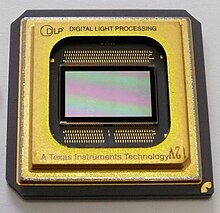Micromirror actuator
A micromirror actuator is a microelectromechanical component for the dynamic modulation of light . Due to the miniaturized structure and the electrical, mechanical and optical properties, it belongs to the group of MEMS or MOEMS. A widespread application is, for example, image projection in beamers , especially DLP projectors .
Types
In the case of micromirror actuators, a distinction is made between so-called microscanners (English microscanners , or also scanning micromirror ) and surface light modulators (English spatial light modulator , SLM).
- With microscanners, a beam of rays is modulated on a continuously moving individual mirror . Light can be guided or "scanned" across a projection surface. Microscanners are used in projection displays , barcode scanners , endoscopy , spectroscopy and many more.
- With area light modulators, the light is modulated via a mirror matrix. The individual mirrors assume discrete deflections over time. This results in the deflection of partial beams or a phase-shifting effect. With the help of a matrix-like arrangement, micromirror actuators can deflect the light from a strong light source in such a way that an image is projected. Examples of surface light modulators are the Digital Micromirror Device (DMD), which represent the technological basis of products such as Digital Light Processing (DLP). DLPs, a trademark of Texas Instruments (TI) are used among others in movie theaters with digital film projectors. The first DMDs were developed at TI in 1987 by Larry Hornbeck and William Ed Nelson .
principle
The micromirror actuators usually consist of individual elements arranged in the form of a matrix, in which the individual micromirror consists of a tiltable reflective surface with an edge length of a few micrometers; The micromirrors on a DMD chip, for example, have an edge length of around 16 µm and are therefore less than a fifth of the width of a human hair. The movement is caused by the force of electrostatic fields. Each micromirror can be adjusted individually in its angle and usually has two stable end states, between which it can switch up to 5000 times within a second.
Applications
The technology has been used for a long time in DLP projectors (including for particularly powerful video projectors ) and rear projection screens . In addition, they can be used for 2D scanner mirrors (for example in cash machines) or even for mask exposers in semiconductor production.
Micromirror actuators for directing light could also be used in building technology in the future: The mirrors are to be installed between the two panes of insulating glazing and can be switched electrostatically as described above. The lighting in the room (intensity and direction) would then depend on the position of the mirrors. Although this technology can already be used on a laboratory scale with small prototypes, a large-scale manufacturing method for mirrors is still lacking for commercial use.
literature
- D. Kallweit, W. Mönch, H. Zappe: Controlled tilting: silicon micromirrors with integrated optical feedback . In: Photonics . tape 2 , 2006, p. 62-65 ( PDF ).
Individual evidence
- ↑ DLP History , accessed on December 23, 2011, engl.
- ↑ Volker Viereck, Qingdang Li, Andreas Jäkel, Hartmut Hillmer: Large-scale application of optical MEMS: micromirror arrays for directing daylight . In: Photonics . No. 2 , 2009, p. 28-29 ( PDF ).


